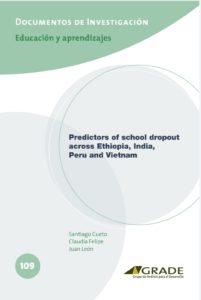Predictors of school dropout across Ethiopia, India, Peru and Vietnam
| Year | : | 2020 |
|---|---|---|
| Author/s | : | Santiago Cueto, , Juan Leon |
| Area/s | : | Education and learning |
Cueto, S.; C. Felipe & J. León (2020). Predictors of school dropout across Ethiopia, India, Peru and Vietnam [Documento de Investigación, 109]. Lima: GRADE.
In this paper the authors utilize the five rounds of Young Lives household surveys across four countries (Ethiopia, India, Peru and Vietnam) to study the characteristics of children who had dropped out of school by 22 years of age. While most children in the longitudinal sample go to primary school, they tend to drop out more often and earlier in Ethiopia. In India most children complete the early grades of school but drop out later, particularly in grades 11 and 13. Researchers find that in all countries, except Vietnam, there is a considerable number of children who drop out of school but at some point return to it, either to complete secondary or drop out again. The reasons provided by children for dropping out across the countries are oftentimes related to poverty: for example, the need to work, or care or provide for family. The multivariate analysis shows that indeed in many cases the wealth level of the family at an early age predicts later dropout, as does maternal education level, students’ early skills and residence in certain regions of each country. There are also some variations across countries; for example, boys are more likely to drop out of school in Ethiopia and Vietnam, and children who have repeated a grade are more likely to drop out of school in Peru. However, having high educational aspirations at early ages seems to be a protective factor against dropping out. This suggests that the value that children place on education may be an important preventative factor against dropping out. Overall, these results suggest the need to act early through education and social protection interventions to target young children who are at risk of dropping out, and the follow their trajectories, providing support as needed to specific groups and even individuals, so that all children may fulfill their right to complete at least secondary education.






